As we discussed in the last Sortie, in 1941 the Spitfire Mark 9 was intended to be a stop-gap design to combat the threat from the German Fw190. It proved to be so successful however, that it continued to be produced until the end of the war in Europe.
In this Sortie, we will take a look at the Spitfire LF Mark 9 and see what it took to become an Ace pilot.
D-Day
A Spitfire’s operational range against targets on the European continent was limited by the need to first cross the English Channel.
After D-day on 6th June 1944, this changed forever, as the Allies launched the largest naval invasion in history. With Spitfires helping to provide air cover, 5 beachheads were successfully captured on the Normandy coast. After joining these areas together, the Allies now had a base of operations from where they could launch an offensive into German held territory. Almost immediately, airfields were constructed and Spitfires began to operate from the front lines in liberated France.
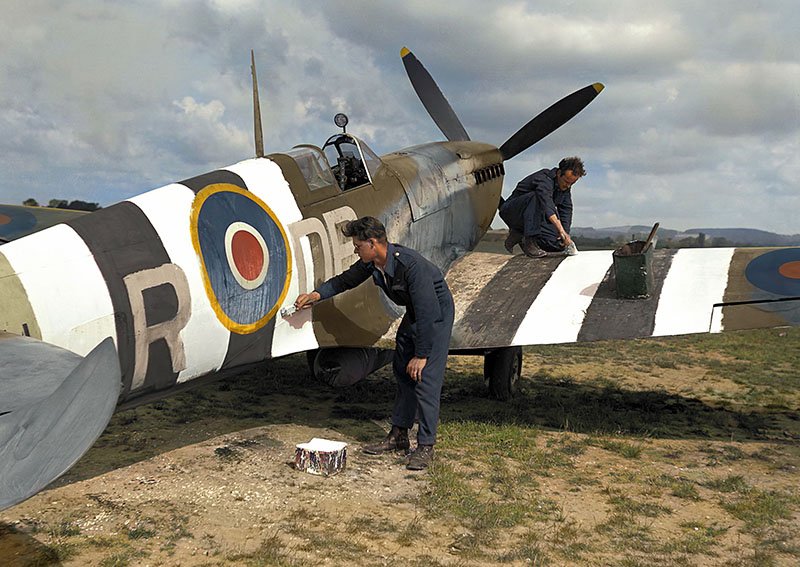
Before D-Day, Spitfires had black and white stripes painted on their sides and wings. This was to help aid identification from a distance and avoid friendly fire incidents
D-Day Pilots
During the Battle of Britain, due to the desperation of the situation, pilots were often thrust into the seat of a Spitfire with little to no prior experience flying the aircraft.
Despite this the RAF were able to secure a decisive victory. In the following years pilot training programmes were set up in Allied nations, such as Canada, where training could take place in an environment free from the threat of attack.
In 1944, the training required for a fighter pilot had risen to a minimum of 18 months. Due to the time needed for each pilot to complete their basic and advanced flight training, travel to England and then be set-up in their operational unit, the majority of new Spitfire pilots taking to the skies on D-Day had started their training in 1941.
Their training had often been provided by many of the experienced pilots that had flown during the Battle of Britain, who were now operationally retired.
The Spitfire LF Mark 9 (IX)
From its maiden flight in 1941 until the D-Day landings the Mark 9 Spitfire had undergone significant developments and improvements. We have heard before about the high-altitude variant that took on the JU-86R at 44,000ft. However, arguably the most important of the Mark 9 variants, was the “LF”, which was specifically optimised for low altitude flight.
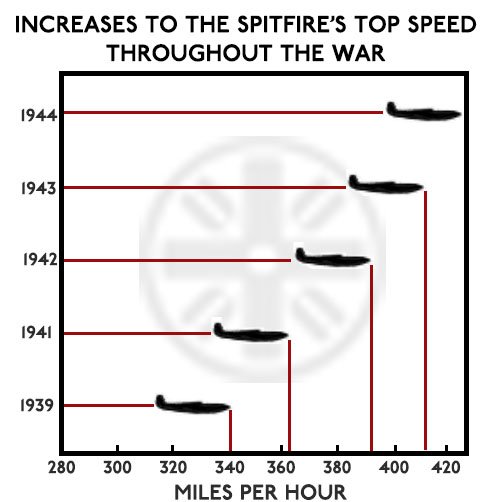
By this stage in the war the Rolls Royce Merlin engine had been able to push the boundaries of a piston engine aircraft to its limits. Still built around the same basic design as the Merlin 3 engine that carried the Mark 1 Spitfires to the skies during the Battle of Britain, the Spitfire LF Mark 9 was powered by the Merlin 66 engine.
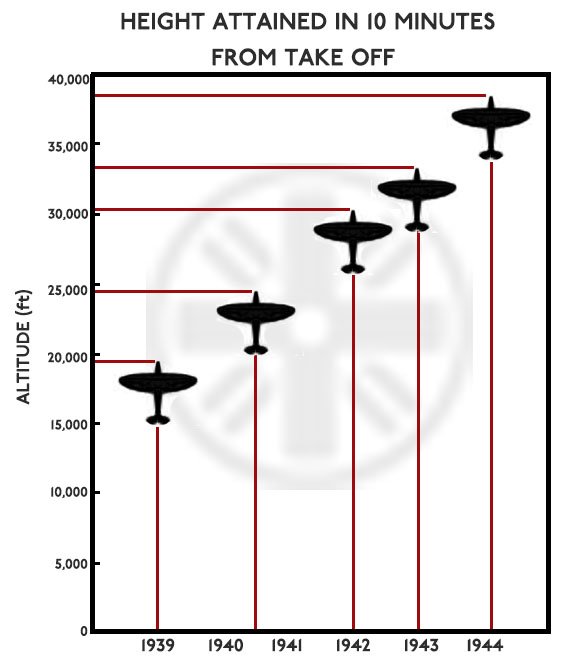
Nearly all of the increases in speed and rate of climb during the Spitfire’s wartime development can be attributed to improvements in the Merlin engine
The huge 27 litre V12 Merlin 66 engine made up 28% of the Spitfire’s empty weight. It was capable of producing 1,705hp, giving the Spitfire incredible speed and acceleration. It could also use a temporary boost of 150 Octane fuel, to raise the output of the engine to over 2,000hp.
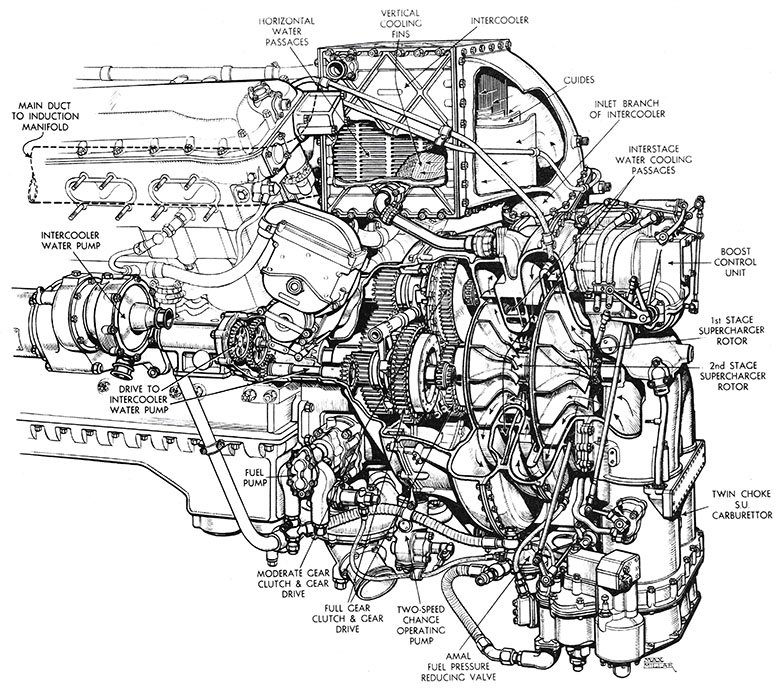
The Merlin 66’s two-stage supercharger was able to force feed air into the engine, allowing the pilot to keep the fuel burning efficiently at higher altitudes as the air became thinner
The Spitfire LF Mark 9 was armed with two 20mm Hispano Mk.II auto-cannons and two Browning AN-M2 .50-caliber machine guns.
The pilot controlled these weapons via a selector switch on the Spitfire’s flight stick. If the pilot pushed up on the button it would fire the Browning machine guns, if pushed down it would fire the 20mm cannons. If the centre was pushed, all four weapons would fire together.
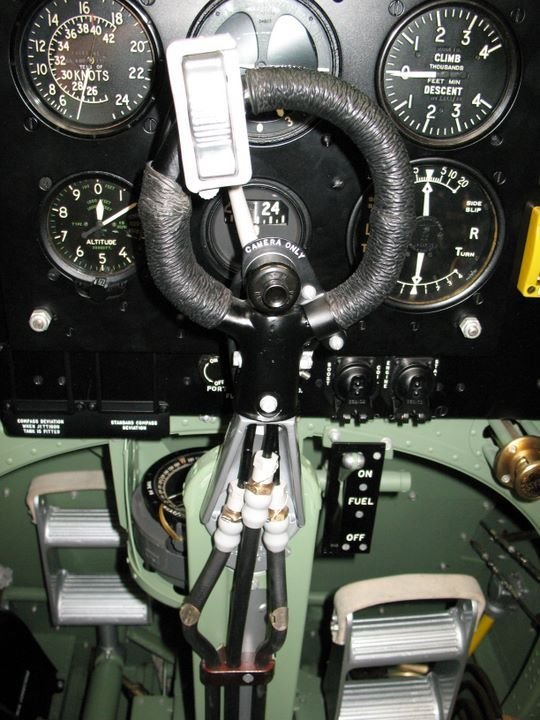
Part of a Spitfire’s cockpit, showing the flight stick and the silver coloured weapon selector switch. You can also see the button for turning the gun camera on
Aerial Victories
It was vitally important for Fighter-Command to keep statistics of how each aircraft performed, which tactics were effective and which pilots were the most competent.
Each pilot was given an official tally of their successes against enemy aircraft. There were 3 categories:
Destroyed:
An aerial victory, sometimes referred to as a “kill”. An enemy aircraft needed to be damaged to the point of being unsalvageable.
Generally crashing nose first into the ground, breaking up in mid-air, or the pilot baling out were solid reasons to claim a destroyed aircraft.
Despite being referred to as a “kill”, it was not necessary for any of the enemy aircrew to perish.
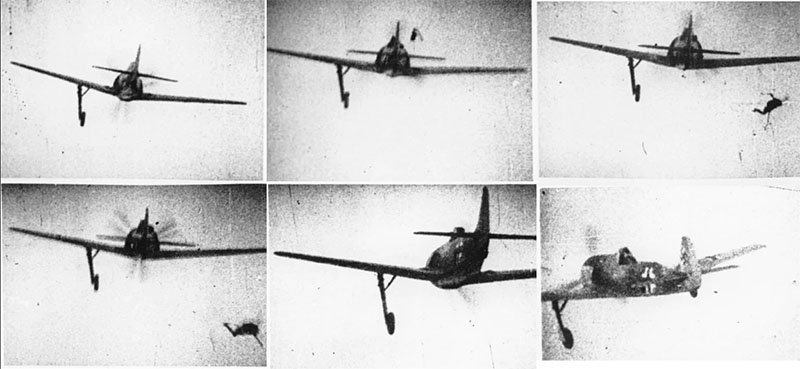
In these dramatic images from a Spitfire’s gun camera, a Bf109 pilot is seen jumping from his damaged aircraft. Such evidence would prove a victory
If more than one pilot attacked and destroyed an aircraft, then if unable to prove otherwise, the victory was shared. This was the split evenly between the claimants, and would be recorded as either 0.5, 0.3 or 0.25 victories.
Damaged:
This was where an enemy aircraft was hit and significantly damaged – enough that it would require repair – but it was not destroyed. This did include cases where the aircraft was destroyed, but the final destruction was not witnessed, if the aircraft fell into cloud cover for instance.
Hits against an aircraft alone were not enough to claim a damaged hit. Any visible damage and the effect of that damage needed to be directly witnessed.
Probable:
This was used on cases where a victory was claimed but could not be proven. However, because it was ambiguous, it was not widely used. Often it was reserved for claims that were not witnessed, but were made by a credible pilot – someone who was already an Ace for example.
Victories were recorded in the format 5/2/1; which would be 5 destroyed, 2 damaged and 1 probable.
Any aircraft that were destroyed on the ground were recorded separately and, like ground vehicles, did not count towards any official score; the exception to this was the US Air-Force which sometimes credited pilots with all the aircraft they destroyed, whether in the air or on the ground.
Problems with Recording Aerial Victories
Pilots tended to over-exaggerate their successes and so it became vital for each claim to be backed up. This usually came from eye-witness accounts on the ground or in the air, or from video footage the pilot had recorded. Post action reports were filed by the pilots and any claims were checked and confirmed by an Intelligence Officer.
More commonly used as the war progressed, footage from gun cameras have left important records as to the terrific skill of the pilots, as well as to the brutal realities of aerial combat.
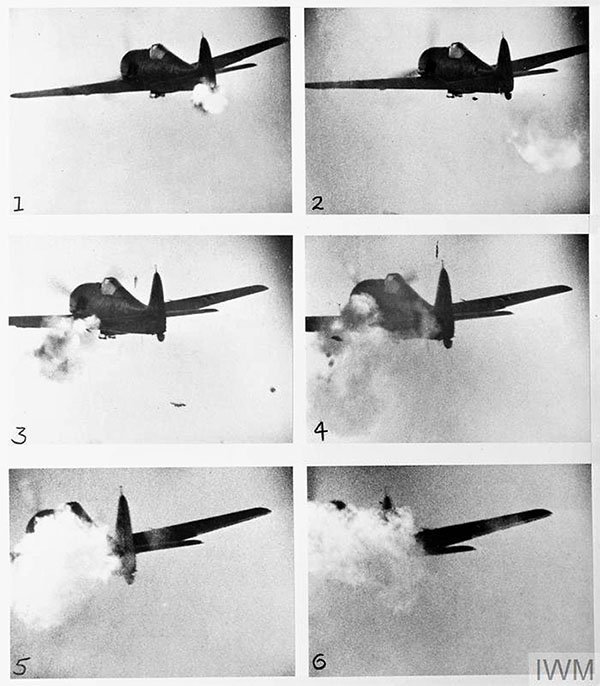
This Fw190 has taken direct hits from a Spitfire’s explosive 20mm cannon shells. In image 1, the tail of the aircraft is hit and parts can be seen falling away. In image 3, we see a second shell hitting the wing and igniting the fuel tank. With no way to extinguish the flames, this pilot would have just seconds to bale out before his aircraft would explode mid-air
After the war ended, claims of victories could be reconciled against official recorded losses from the opposing side. The differences were often immense.
Exaggerated claims
As an example, during the height of the Battle of Britain on 18th August 1940, the Luftwaffe claimed 147 aircraft destroyed, while the RAF claimed 144 destroyed. After weeks of similar claims, Herman Goring, who had already underestimated the starting strength of RAF Fighter Command, believed the RAF was a finished force. This led to the fateful decision to turn attention away from the airfields during the Battle.
The reality was that on that day British losses were 68 and the German losses were 69 aircraft.
In another instance, during the Battle of Kursk in July 1943, Soviet pilots claimed 878 German planes destroyed. This number, however, was significantly higher than the total number of Luftwaffe aircraft in the entire region. Instead, German records show that they had lost 80 aircraft.
The additional claims were not necessarily dishonest or as a result of propaganda. Dogfighting was often over in a few seconds and was full of adrenaline and confusion. Often more than one pilot would shoot at the same aircraft, or an aircraft thought incapacitated may have still been able to glide to a safe landing.
Ace Pilots
To make an “Ace”, a pilot needed to have 5 or more confirmed aerial victories against enemy aircraft.
The majority of pilots throughout the war would not score any aerial victories. However, they still played a vital role by spotting enemies for their wingmen and providing cover.
Pilots that made Ace needed to be daring, aggressive and decisive. It was often these same attributes that would lead to them later losing their lives.
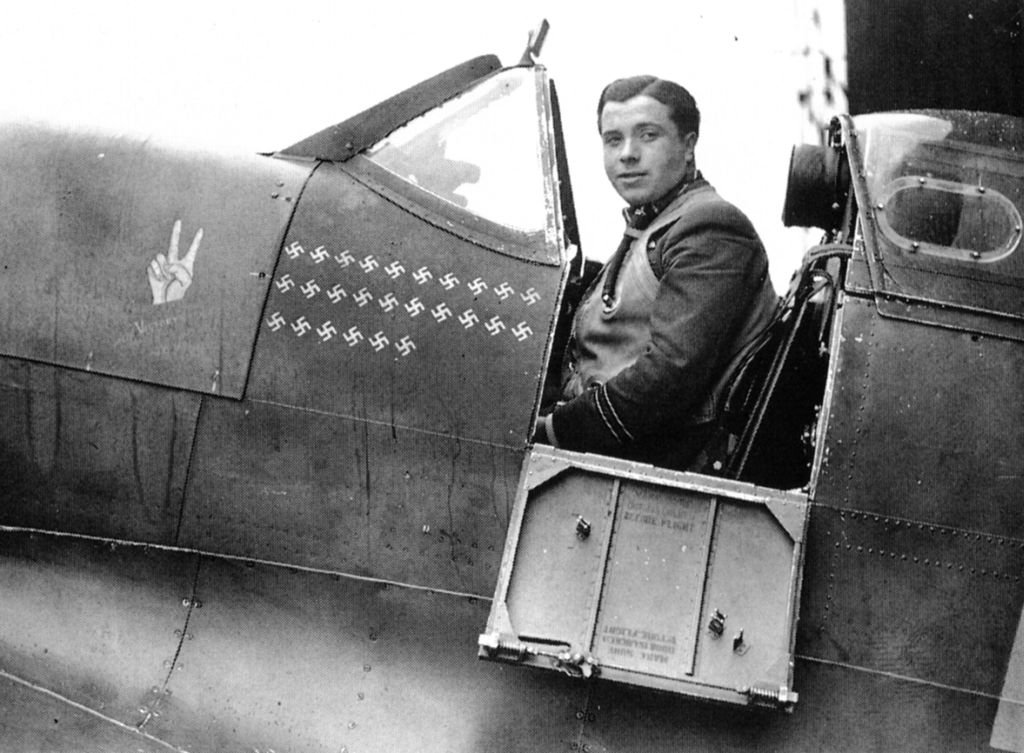
Many Ace pilots would record their victories by painting the tally on their aircraft. This RAF Spitfire pilot is Eric Lock, credited with 26/0/9
Over the course of the Second World War, approximately 7,450 pilots were able to make Ace from all sides in the conflict. Of these, 4,150 came from Allied nations, with 3,300 coming from Axis nations (including Finland and Japan). These represented perhaps less than 5% (1 in 20) of all fighter pilots in the war.
Despite being a relatively small percentage of the total number of pilots, their impact was significant. Between 120,000-140,000 aircraft were destroyed by these Aces, accounting for the destruction of 60-70% of all aircraft lost in combat during the war.
Destroying 5 aircraft over a career was incredibly difficult, but some skilled pilots managed to achieve this task in a single day. These victories were often split over several sorties undertaken on the same day.
The story you’re about to read concerns a pilot who became an Ace in a single mission. Incredibly, this was the pilot’s first encounter with Luftwaffe aircraft and it was all accomplished within 5 minutes. He was Spitfire pilot Dick Audet.
Dick Audet
Richard Joseph “Dick” Audet came from Lethbridge in the mid-Western Canadian province of Alberta.
In August 1941, aged 19 years old, Audet enlisted in the Royal Canadian Air Force at Calgary. He trained as a fighter pilot and was commissioned as a Pilot Officer in October 1942.
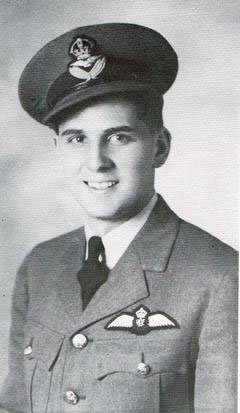
Audet’s enlistment photograph
In December of 1942, he moved to England and continued his training. After completing both his elementary and advanced flying courses, Audet was promoted to the rank of Flying Officer in April 1943. He then moved to an Operational Training Unit and it was here he was introduced to the Spitfire. Audet’s instructors noted that he was a naturally gifted pilot, being “keen, sensible and steady” and that he had exceptional eyesight.
In July 1944, he married his English sweetheart Iris Gibbins.
After 3 years in training, on 14th September 1944, Audet joined 411 Squadron of the Royal Canadian Air Force. The squadron was known as the Grizzly Bears after their Squadron emblem and the pilots called themselves the Roaring Boys. On 23rd October 1944, Audet was promoted again, this time to the rank of Flight Lieutenant.
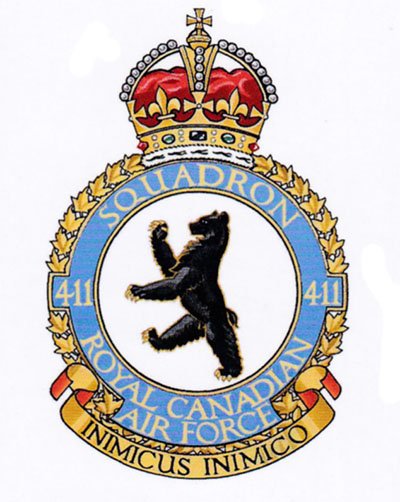
Audet’s Day
Below are Dick Audet’s own words describing his encounter. Remember that Audet had never encountered German aircraft up until this point and that he was able to achieve all this with enough ammunition in his Spitfire LF Mark 9 for just 10 seconds of sustained fire.
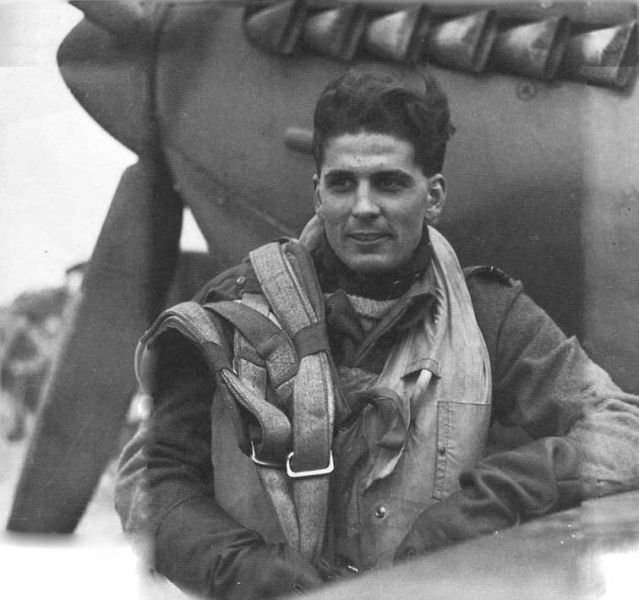
I will explain some of the terms he uses:
a/c: Aircraft.
e/a: Enemy Aircraft.
Me 109: The Allies commonly called the Bf109 the Me109 after its designer, Willy Messerschmitt.
Me 262: This is the Luftwaffe’s fast jet fighter, also designed by Messerschmitt.
Strikes: These are the visible hits on the enemy aircraft. These are usually caused by the shells of the 20mm cannons exploding on impact with an aircraft.
Dick Audet’s Report
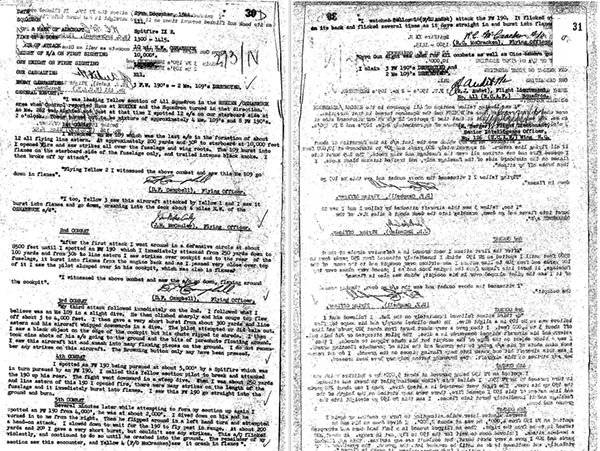
Audet’s original combat report, certified by 4 other pilots and an intelligence officer
“I was leading Yellow section of 411 Squadron in the Rheine/Osnabrück area when Control reported Huns at Rheine and the squadron turned in that direction. An Me262 was sighted and just at the time I spotted 12 e/a on our starboard side at 2 o’clock. These turned out to be a mixture of approximately 4 Me109s and 8 Fw190s.
1st Combat
I attacked an Me109 which was the last a/c in the formation of about twelve all flying line astern. At approximately 200 yds and 30° to starboard at 10,000 feet I opened fire and saw strikes all over the fuselage and wing roots. The 109 burst into flames on the starboard side of the fuselage only and trailed intense black smoke. I then broke off my attack.
2nd Combat
After the first attack I went around in a defensive circle at about 8,500 feet until I spotted an Fw190 which I immediately attacked from 250 yards down to 100 yards and from 30° to line astern. I saw strikes over cockpit and to the rear of the fuselage. It burst into flames from the engine back, and as I passed very close to the top of it I saw the pilot slumped over in his cockpit, which was also in flames.
3rd Combat
My third attack followed immediately on the 2nd. I followed what I believed was an Me109 in a slight dive. He then climbed sharply and his coupé top flew off about 3 to 4,000 feet. I then gave a very short burst from about 400 yards and line astern and his aircraft whipped downwards in a dive. The pilot attempted or did bale out. I saw a black object on the edge of the cockpit but his ‘chute ripped to shreds. I then took ciné shots his a/c going to the ground and bits of parachute floating around. I saw this aircraft hit and smash into many flaming pieces on the ground. I not remember any strikes on this aircraft. The Browning button may only have been pressed.
4th Combat
I spotted a Fw190 being pursued at about 5,000’ by a Spitfire which was in turn pursued by an Fw190. I called this Yellow section pilot to break and attacked the 190 up his rear. The fight went downwards in a steep dive. When I was about 250 yards and line astern of this 190 I opened fire. There were many strikes on the length of the fuselage and it immediately burst into flames. I saw this Fw190 go straight into the ground and burn.
5th Combat
Several minutes later while attempting to form my section up again I spotted an Fw190 from 4,000 feet. He was at about 2,000 feet. I dived down on him and he turned in to me from the right. Then he flipped around in a left hand turn and attempted a head-on attack. I slowed down to wait for the 190 to fly past in range. At about 200 yds and 20° I gave a very short burst, but couldn’t see any strikes. This a/c flicked violently, and continued to do so until he crashed into the ground. The remainder of my section saw this encounter, and Yellow 4 (F/O McCracken) saw it crash in flames.
Gyro Gun sight was used for all combats as well as Cine-camera gun.”
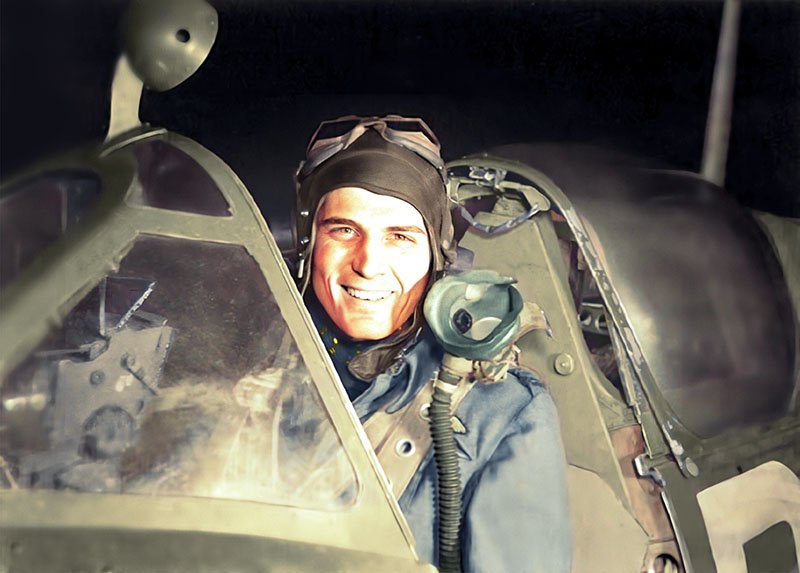
A photograph of Dick Audet taken after his famous sortie. At 6’3″ (190cm) tall, you can see he would have had to duck to close his Spitfire’s canopy
Audet’s later Career
Following this incredible encounter, Audet was awarded the Distinguished Flying Cross (DFC).
Within a month he went on to score another 5 aircraft shot down and one shared victory. This brought his tally to 7.5 Fw190s and 2 Bf109s destroyed, along with 1 destroyed and 1 damaged Me262, with another destroyed on the ground. This gave him a scoresheet of 10.5/1/0.
During the later stages of the war, as there were fewer and fewer Luftwaffe aircraft in the skies, Audet flew many ground attack missions, taking out “soft” targets such as airfields, factories, tanks, trucks and trains.
AUDET’S FINAL MISSION
| On 3rd March 1945, after having just returned from a week’s leave, Audet led 411 squadron on an attack on a train near Coesfeld, Germany. During the attack, Audet’s Spitfire was hit by flak and burst into flames. Flying at such a low level, just 500ft, gave Audet no chance of baling out and his Spitfire crashed into a wooded area and was seen to explode. It was his 83rd Sortie. |
Dick Audet was only 22 years old and had been married for just 8 months. He was posthumously awarded a bar to his DFC medal.
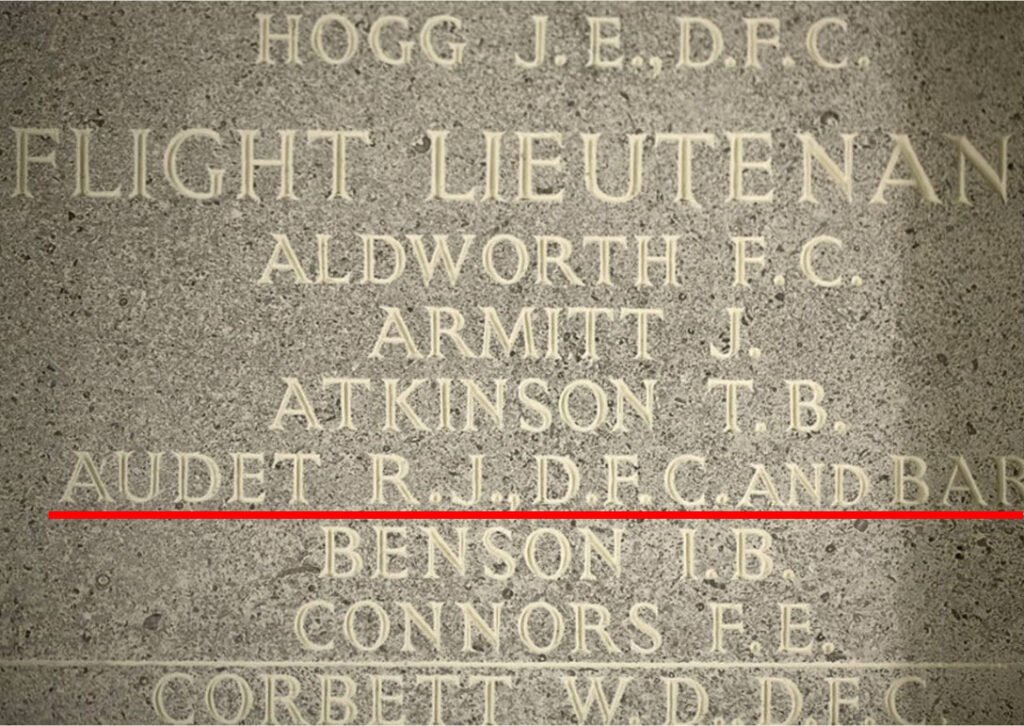
With his remains never recovered, Dick Audet does not have a grave. Instead his name appears alongside another 400 casualties of the war on the Lethbridge Cenotaph in his home town
He was one of 27 pilots from 411 Squadron that lost their life during the war. From D-Day to VE-Day, the 411 pilots would claim 75 enemy aircraft destroyed along with hundreds of ground targets. With 401 and 412 Squadrons, 411 together formed the 126 Wing of the Royal Canadian Air Force. During the war, the 126 Wing would become the most successful group of Spitfires that ever took to the skies, with pilots such as Audet demonstrating the full potential of the Spitfire in combat. Their sacrifices helped save many thousands of lives, by keeping the skies clear and the troops on the ground safe.
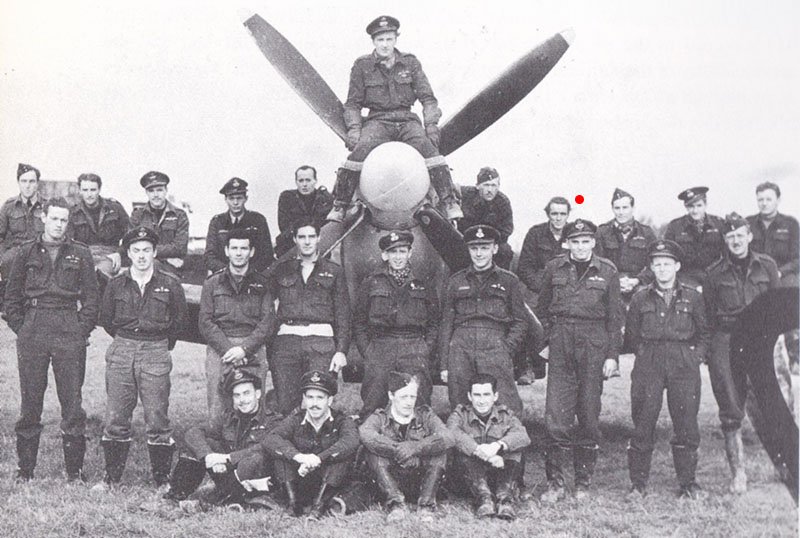
Audet, marked with a red dot above him, is here standing alongside the other 411 Squadron pilots in October 1944
The Watchmaker – Starting a Business
Following on from last Sortie’s discussion on my watchmaker training and education, as I began my studies in 2011, it became apparent very quickly that the British watchmaking industry was in a tough situation.
Despite British talent having invented and engineered the technology behind a modern watch, at the time there were just 12 watches a year being produced in the British Isles. Each of these watches, which cost in excess of £100,000, were hand-made by Roger Smith, in his Isle of Mann workshop.
Some view Roger, originally from Bolton near Manchester, as the world’s greatest living watchmaker.
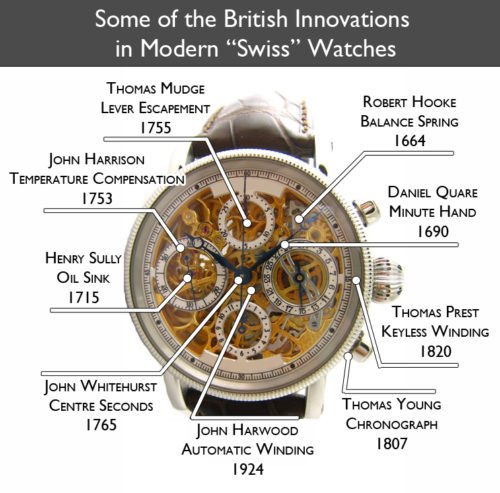
Britain had also been not just the home of watch innovation, but was also one of the historic world centres for watch manufacturing; with the accuracy of British made chronometres allowing ships to navigate the oceans of the world and dominate trade.
This was still the case at the start of the 20th Century, a testament to this being when Rolex was founded in 1905, they chose London rather than Switzerland to base their company. It seemed a shame that all that knowledge and expertise had now been lost.
So, in 2011, just a month after starting my studies, I founded the Great British Watch Company (GBW). I set the company 4 lofty objectives:
- To help educate and inform the public about Britain’s historic role in horology
- To offer a limited range of bespoke British designed, hand crafted and assembled watches using only 100% British sourced materials, skills and technology
- To build and maintain the reputation of the Made in Great Britain stamp on timepieces
- To aid and enable brands of watch the opportunity to display Made in Great Britain on their dials and cases
Next time, I will talk about the journey towards trying to meet these objectives and my future plans.
Next Sortie
We will look at the types of missions the Spitfire LF Mark 9 undertook and see what life was like for the pilots operating from the front lines.
See you there.
https://www.great-british-watch.co.uk/sortie-12-spitfire-operations/




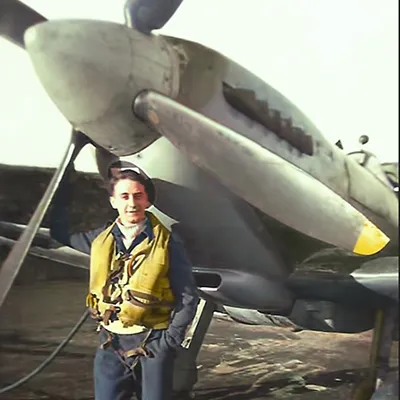

Sortie 12 – Spitfire Operations – Great British Watch Company
26 July, 2022 at 6:56 pm
[…] As we discussed in the last Sortie, the Spitfire produced some of the world’s top fighter ace pilots. […]
Sortie 13 – The Few Spitfire – Great British Watch Company
26 July, 2022 at 6:57 pm
[…] 401 and 412 Squadrons, 411 Squadron formed the 126 Wing of the Royal Canadian Air Force, who, as I have mentioned in a previous Sortie, were the most successful group of Spitfire pilots during the […]
Sortie 10 – A New Adversary – Great British Watch Company
26 July, 2022 at 7:00 pm
[…] Sortie 11 – Spitfire Aces Post navigation ← Previous PostNext Post → […]